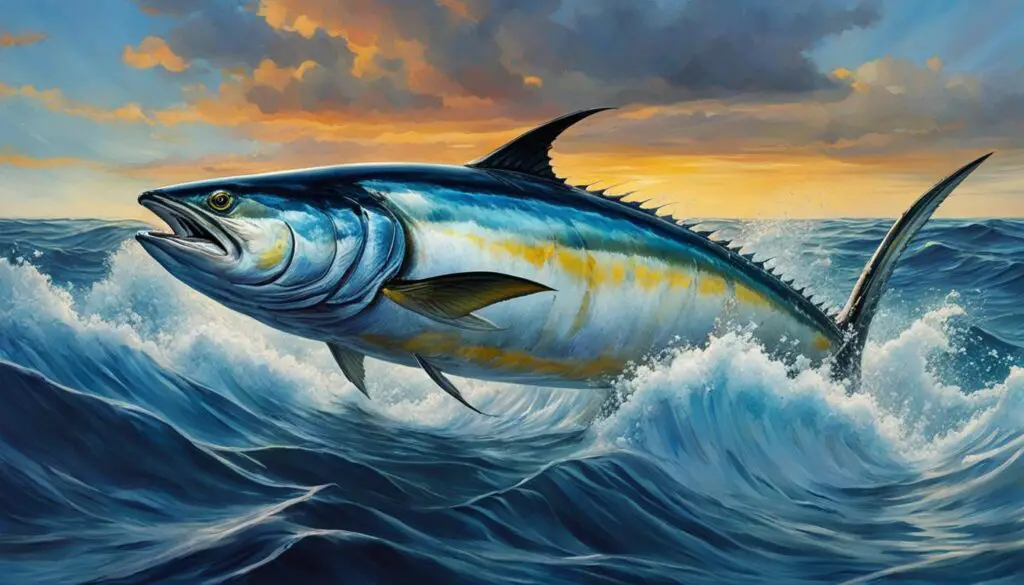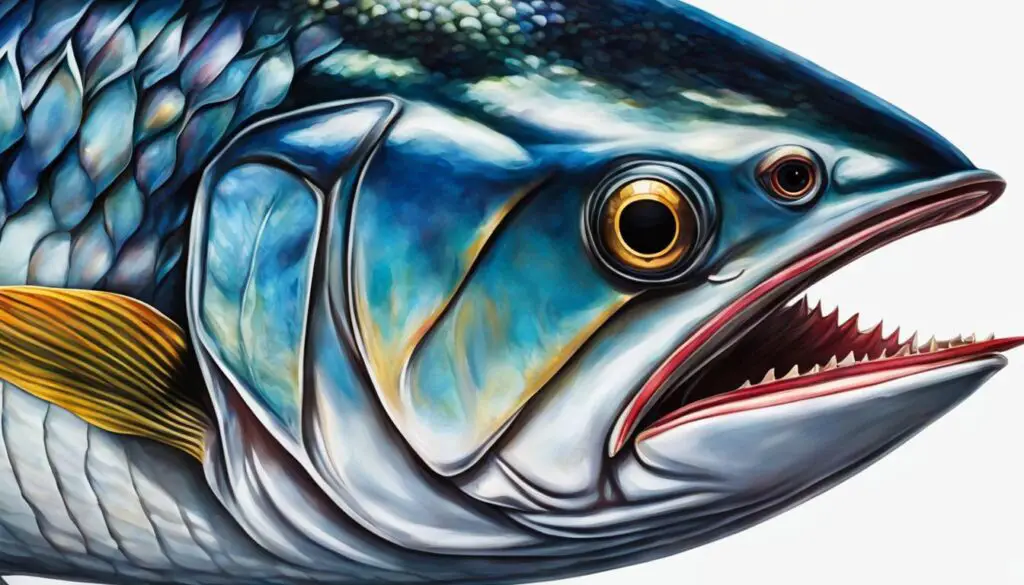When it comes to the size of tuna fish, it’s hard to ignore the astounding measurements of these ocean dwellers. From the majestic bluefin tuna to the speedy yellowfin and skipjack varieties, tuna fish can grow to impressive dimensions. Let’s dive into the details and explore just how large these magnificent creatures can become.
Key Takeaways:
- The average size of an Atlantic bluefin tuna is around 6.5 feet in length and 550 pounds in weight.
- Some bluefin tuna can reach up to 8 feet in length and weigh as much as 1500 pounds.
- Yellowfin tuna and skipjack tuna are smaller, with average lengths of 5 feet and 4 feet, respectively.
- Overfishing poses a significant threat to the long-term survival of bluefin tuna populations.
- Conservation measures and responsible fishing practices are crucial for the sustainability of tuna fish.
The Extraordinary Size of Atlantic Bluefin Tuna
When it comes to size, the Atlantic bluefin tuna reigns as one of the most impressive tuna species in the world. With an average length of 6.5 feet and a weight of around 550 pounds, these majestic creatures already command attention. But it’s their record-breaking catches that truly showcase their extraordinary size. The largest Atlantic bluefin tuna ever recorded weighed a staggering 1,496 pounds, caught off the coast of Nova Scotia, Canada. Measuring nearly 8 feet in length, this massive fish highlights the jaw-dropping dimensions that the bluefin tuna can reach.
In comparison to other tuna species, such as the yellowfin and skipjack tuna, the Atlantic bluefin tuna stands out as a true giant. While the average length of yellowfin tuna is around 5 feet and skipjack tuna measures around 4 feet, the bluefin tuna surpasses them all in sheer size and presence.
The exceptional size of the Atlantic bluefin tuna is a testament to the awe-inspiring wonders of the ocean. Whether you’re an angler or a marine enthusiast, encountering one of these massive creatures is an experience like no other.
The Record-Breaking Catches
Over the years, avid fishermen have made record-breaking catches of the Atlantic bluefin tuna, further cementing its status as a true giant among fish. These catches not only showcase the remarkable size of this species but also demonstrate the thrill and excitement that comes with reeling in such a massive fish. From the 1,496-pound catch off the coast of Nova Scotia to the notable catches in Prince Edward Island, these records highlight the abundance of large bluefin tuna in certain fishing destinations.
For those seeking an unforgettable fishing experience, targeting the Atlantic bluefin tuna promises an adventure like no other. The opportunity to witness and potentially catch one of these giants is nothing short of extraordinary.
The Incredible Appetite and Diet of Bluefin Tuna
Bluefin tuna have an incredible appetite and a varied diet, making them apex predators in the ocean. They consume a wide range of prey, including smaller fish, crustaceans, squids, eels, and other sea creatures. Their insatiable hunger and ability to consume massive amounts of food contribute to their impressive size and make them true apex predators.
Bluefin tuna’s diet consists of both pelagic species, such as mackerel and herring, as well as invertebrates like crustaceans and squid. They are known to feed in deep-feeding areas and near offshore islands and reefs. Their diverse diet allows them to adapt to different ecological niches and thrive in various oceanic regions.
Feeding Habits
- Bluefin tuna are known for their voracious appetite, consuming large quantities of food to sustain their size and energy requirements.
- They exhibit both opportunistic and selective feeding behaviors, actively pursuing prey and targeting specific species.
- Bluefin tuna are highly skilled hunters, using their speed, agility, and keen senses to locate and capture their prey.
- They are known to undertake long-distance migrations in search of food, following the seasonal movement of their preferred prey species.
Bluefin tuna’s ability to consume massive amounts of food and their position as apex predators highlights their crucial role in maintaining the balance of the marine ecosystem. Their feeding habits allow them to regulate prey populations and contribute to the overall health and stability of the oceanic food web.
Conservation Considerations
Despite their impressive feeding abilities and ecological importance, bluefin tuna populations are facing significant conservation challenges due to overfishing. Their prized meat has led to intense commercial fishing pressure, resulting in population declines in many regions.
To ensure the long-term survival of bluefin tuna and preserve their crucial role in the marine ecosystem, sustainable fishing practices and conservation efforts are necessary. Strict regulations, including catch limits and seasonal closures, can help protect spawning grounds and ensure the sustainability of bluefin tuna populations. Collaborative international efforts are also essential to enforce fishing regulations and promote responsible fishing practices.
It is crucial for consumers to be aware of the environmental impact of their seafood choices. By choosing sustainably sourced seafood and supporting fisheries that adhere to responsible fishing practices, individuals can contribute to the conservation of bluefin tuna and other marine species.
World Record Catches of Atlantic Bluefin Tuna
Atlantic bluefin tuna holds multiple world records for its astonishing size and weight. The largest recorded catch of a bluefin tuna weighed a staggering 1,496 pounds and was caught off the coast of Nova Scotia, Canada, in 1979 by fisherman Ken Fraser. This record-breaking catch remains unmatched to this day, solidifying bluefin tuna’s status as one of the largest and most impressive fish species in the ocean.
Noteworthy catches also include a bluefin tuna weighing 1,178 pounds and another weighing 1,116 pounds, both caught off the coast of Prince Edward Island. These incredible catches demonstrate the abundance of large bluefin tuna in the waters near Nova Scotia and Prince Edward Island, making them prime fishing destinations for anglers seeking to experience the thrill of reeling in these massive fish.
“The feeling of landing a bluefin tuna of such immense size is indescribable. It’s a testament to the raw power and beauty of these magnificent creatures,” said seasoned angler John Adams.
These record-breaking catches serve as a testament to the size and strength of bluefin tuna, attracting anglers from around the world to test their skills and embark on the ultimate fishing adventure.

Bluefin Tuna in Monterey: A Catch of a Lifetime
In the picturesque coastal town of Monterey, California, fishermen Arthur Melgoza and Carlos Morales embarked on a fishing adventure they would never forget. On a sunny day, with the vast Pacific Ocean stretching before them, they set out to reel in the catch of a lifetime – a magnificent bluefin tuna. With their expertise and determination, they successfully landed a stunning 220-pound bluefin tuna, measuring an impressive 83 inches in length. The sheer size and power of this prized fish made it a true testament to their fishing skills.
“Reeling in that massive bluefin tuna was like nothing I’ve ever experienced,” shared Arthur Melgoza. “The adrenaline rush was incredible as we battled against the strength and speed of the fish. It was truly a moment of triumph.”
Monterey may not be a common location for bluefin tuna, but during certain times of the year, the warming of the ocean attracts these magnificent creatures to the area. The fruitful waters of Monterey Bay provide an opportunity for anglers to try their luck in catching these prized fish. The thrill of reeling in a bluefin tuna and the breathtaking natural beauty of Monterey make it a memorable fishing experience like no other.
Whether you are an experienced angler or a novice adventurer, fishing for bluefin tuna in Monterey promises excitement and a chance to witness the awe-inspiring power and beauty of these incredible creatures. Monterey’s rich marine ecosystem and diverse fishing grounds offer ample opportunities to hook into a bluefin tuna and create memories that will last a lifetime.
The Impressive Size and Characteristics of Bluefin Tuna
Bluefin tuna, specifically the Atlantic bluefin tuna, are known for their impressive size and remarkable physical characteristics. They have a streamlined, torpedo-shaped body built for speed and endurance. The average size of an Atlantic bluefin tuna is 6.5 feet in length, although they can reach lengths of up to 8 feet. In terms of weight, the average is around 550 pounds, but they can weigh up to 1500 pounds. Bluefin tuna are easily distinguishable by their shiny blue color on the top and shimmery silver/white color on the bottom. They also have smaller pectoral fins compared to other tuna species. These features contribute to their ability to swim at high speeds, reaching up to 43 mph.

Bluefin tuna’s impressive size is a result of their incredible appetite and varied diet. As apex predators, they consume a wide range of prey, including smaller fish, crustaceans, squids, eels, and other sea creatures. Their diet is so diverse that they are considered to have no predators above them on the food chain. Bluefin tuna’s insatiable hunger and ability to consume massive amounts of food contribute to their impressive growth. They are known to feed in deep-feeding areas and near offshore islands and reefs.
Bluefin tuna’s large size and physical characteristics make them highly sought after by fishermen. Their strength and fighting abilities make them a thrilling catch, requiring heavy tackle and fishing belts to handle their powerful runs and dives. However, the increasing demand for bluefin tuna meat has led to overfishing and population decline, making responsible fishing practices and conservation efforts crucial for their long-term survival. It is important to appreciate the impressive size and characteristics of bluefin tuna while also recognizing the need for sustainable fishing practices to protect this magnificent species for future generations.
Bluefin Tuna Spawning and Habitat
Bluefin tuna spawn in the Gulf of Mexico, during the months of April to June. This region serves as a crucial habitat for their reproductive activities. During the spawning season, millions of eggs are laid by multiple males and females. These eggs hatch within 48 hours, giving rise to the next generation of bluefin tuna. The Gulf of Mexico provides the necessary conditions for successful reproduction, with its warm waters and abundant food sources.
Bluefin tuna are known for their migratory behavior, moving between different habitats throughout their lives. They are native to the Atlantic Ocean, from Newfoundland to the Gulf of Mexico, as well as the Mediterranean Sea. These fish are capable of thriving in both cold and tropical waters, allowing them to cover vast distances in search of food and suitable spawning grounds. Their ability to adapt to various environments contributes to their wide distribution and global significance as a migratory species.
Bluefin tuna exhibit broadcast spawning habits, where multiple males and females release their sperms and eggs simultaneously to maximize fertilization. This reproductive strategy increases the chances of successful reproduction and the survival of offspring. By spawning in large numbers and in specific regions like the Gulf of Mexico, bluefin tuna ensure the continuation of their species despite the challenges they face.
Protecting Spawning Grounds
To preserve the spawning grounds and habitats of bluefin tuna, conservation efforts focus on creating protected areas and implementing sustainable fishing practices. These measures aim to minimize disturbances in the spawning areas, regulate fishing activities, and reduce the impact of human activities on the reproductive success of bluefin tuna. By safeguarding their spawning grounds, we can contribute to the long-term survival of this magnificent species and ensure the stability of the marine ecosystem.
- Establishing marine protected areas in key spawning regions to reduce disturbances and provide a safe environment for reproduction.
- Implementing fishing regulations and quotas to prevent overfishing and allow bluefin tuna populations to recover.
- Monitoring and enforcing compliance with fishing regulations, using advanced technologies such as satellite tracking and vessel monitoring systems.
- Promoting sustainable seafood consumption and raising awareness about the importance of responsible fishing practices to reduce the demand for bluefin tuna meat.
By adopting these conservation measures, we can protect the spawning grounds and habitats of bluefin tuna, ensuring the survival of this iconic fish for future generations to come.
Fishing Techniques for Bluefin Tuna
Fishing for bluefin tuna requires a combination of skill, knowledge, and the right techniques. Here are some effective methods for catching bluefin tuna:
Trolling:
Trolling is a popular technique used to catch bluefin tuna. It involves dragging lures or baited lines behind a moving boat to attract the fish. The key is to mimic the movement of their natural prey and entice the tuna to bite. Deep-diving plugs, feathered lures, and skirted trolling baits are commonly used for this method.
Jigging:
Jigging is another effective technique for targeting bluefin tuna. It involves dropping a weighted lure to the desired depth and then quickly reeling it back up. This action imitates the movement of injured baitfish, attracting the attention of hungry tuna. Slow-pitch and butterfly jigs are commonly used for jigging, with varying colors and weights to match the conditions.
Bait and Lures:
Using live bait, such as squid or mackerel, is a proven method for enticing bluefin tuna. The natural movement and scent of live bait can be irresistible to these large fish. Additionally, artificial lures such as poppers, swimbaits, and soft plastics can also be effective in triggering the predatory instincts of bluefin tuna.
Regardless of the technique used, it is essential to practice responsible fishing practices and adhere to regulations to ensure the sustainability of bluefin tuna populations. This includes using appropriate gear, releasing undersized or unwanted fish, and following catch limits. By employing these techniques and practicing responsible fishing, anglers can enjoy the thrill of catching bluefin tuna while contributing to their conservation.

Bluefin Tuna as a Culinary Delicacy
Bluefin tuna is highly regarded as a culinary delicacy both in Japan and around the world. Its exquisite taste and unique flavor profile have made it a sought-after ingredient in sushi and sashimi. The rich, buttery texture of bluefin tuna meat is often described as melting in your mouth, leaving a lingering umami sensation. The delicate balance of flavors and the perfect combination of lean and fatty sections create an unparalleled dining experience.

Bluefin tuna sushi is particularly renowned for its exceptional quality and taste. The tender slices of raw bluefin tuna, expertly prepared by skilled sushi chefs, showcase the natural flavors of the fish. Whether enjoyed on its own or paired with traditional sushi accompaniments such as soy sauce, wasabi, and pickled ginger, bluefin tuna sushi offers a culinary experience like no other.
“Bluefin tuna is truly a culinary treasure. Its rich flavor and smooth texture are simply incomparable. Every bite is an indulgence, a moment of pure gastronomic bliss.”
However, the increased demand for bluefin tuna has raised concerns about its sustainability. Overfishing and illegal fishing practices have led to a decline in bluefin tuna populations, and conservation efforts are crucial to protect this magnificent species. As consumers, it is important to be mindful of the environmental impact of our choices and support sustainable alternatives to ensure the long-term viability of bluefin tuna as a culinary delight.
Regulatory Measures for Bluefin Tuna Conservation
The conservation of bluefin tuna is a top priority, and as such, there are strict regulatory measures in place to protect this species. These regulations aim to manage fishing efforts, monitor populations, and promote responsible fishing practices. Obtaining fishing permits is a crucial requirement for fishermen to ensure the sustainability of bluefin tuna populations.
Conservation efforts for bluefin tuna include the implementation of catch limits, size restrictions, and seasonal fishing closures. These measures prevent overexploitation and allow the bluefin tuna population to recover and thrive. Additionally, monitoring fishing efforts through data collection and reporting enables authorities to assess the health of the population and make informed management decisions.
International cooperation plays a vital role in bluefin tuna conservation. Collaborative efforts between countries, organizations, and scientists aim to establish sustainable fishing practices, protect habitats, and combat illegal fishing activities. By working together, we can ensure the long-term survival of bluefin tuna and preserve this magnificent species for future generations.
Bluefin Tuna – A Bounty and a Concern
Bluefin tuna, known for their impressive size and delectable flavor, have become both a prized catch and a cause for concern. The increasing demand for bluefin tuna meat has led to population declines and sustainability concerns. Overfishing and illegal fishing practices have further exacerbated the decline of bluefin tuna populations.
The population decline of bluefin tuna raises serious concerns about the long-term viability of this species. Conservation initiatives and international regulations have been implemented to protect and restore these populations. However, monitoring and enforcing fishing regulations remain ongoing challenges in curbing illegal fishing practices and ensuring the sustainability of bluefin tuna.
In light of these concerns, it is crucial to raise awareness about the importance of sustainable seafood consumption. Responsible angling practices, including catch-and-release techniques, can contribute to the conservation of bluefin tuna. By promoting responsible fishing practices and supporting conservation initiatives, we can help protect this iconic species and preserve the thrill of fishing for bluefin tuna for generations to come.
Conservation Initiatives for Bluefin Tuna
- Implementing strict fishing regulations to limit catch sizes and enforce fishing permits.
- Monitoring fishing efforts and minimizing bycatch to protect bluefin tuna populations.
- Collaborating on international conservation initiatives to promote sustainable fishing practices.
- Supporting research and scientific studies to better understand the biology and behavior of bluefin tuna.
“The declining population of bluefin tuna demands urgent action to protect and restore their numbers. Conservation efforts and responsible fishing practices are paramount in ensuring the survival of this magnificent species.” – Marine Conservation Society
A Thrilling Pursuit: Fishing for Bluefin Tuna
Fishing for bluefin tuna is an experience like no other. The adrenaline rush of reeling in these massive creatures, known for their strength and fighting abilities, is truly exhilarating. From the moment you feel the first tug on your line, you know you’re in for a thrilling adventure.
Catching a bluefin tuna is a memorable moment that stays with you for a lifetime. The sheer size and power of these fish make the pursuit all the more exciting. As you battle against their powerful movements and witness their impressive acrobatics, every second spent fighting the tuna becomes a testament to your skill and determination.
Responsible angling is key when fishing for bluefin tuna. These magnificent creatures need our protection to ensure their survival for future generations. By following fishing regulations, practicing catch-and-release techniques, and promoting sustainable fishing practices, we can all play a role in safeguarding the bluefin tuna population and preserving the joy of this incredible fishing experience.
FAQ
How big do tuna fish get?
The Atlantic bluefin tuna, one of the largest tuna species, can reach an average length of 6.5 feet and weigh around 550 pounds. However, they can grow much larger, with some individuals reaching lengths of up to 8 feet and weights of 1500 pounds.
How does the size of bluefin tuna compare to other tuna species?
The Atlantic bluefin tuna is significantly larger than other tuna species. The average length of a bluefin tuna is approximately 6.5 feet, while the average length of a yellowfin tuna is 5 feet and a skipjack tuna is 4 feet.
What do bluefin tuna eat?
Bluefin tuna are apex predators and have a diverse diet. They consume smaller fish, crustaceans, squids, eels, and other sea creatures. Their diet includes pelagic species like mackerel and herring, as well as invertebrates such as crustaceans and squid.
What are some record-breaking catches of Atlantic bluefin tuna?
The largest recorded catch of an Atlantic bluefin tuna weighed 1,496 pounds and was caught off the coast of Nova Scotia, Canada. Other notable catches include a bluefin tuna weighing 1,178 pounds and a 1,116-pound bluefin tuna, both caught off Prince Edward Island.
Have bluefin tuna been caught in Monterey?
Yes, bluefin tuna has been caught in Monterey, California. Fishermen have had thrilling experiences reeling in these large fish. Despite not being a common location for bluefin tuna, certain times of the year attract them to the area due to the warming of the ocean.
What are the physical characteristics of bluefin tuna?
Bluefin tuna have a streamlined, torpedo-shaped body built for speed and endurance. They can reach lengths of up to 8 feet and have a shiny blue color on the top and shimmery silver/white color on the bottom. Their pectoral fins are smaller compared to other tuna species.
What is the spawning behavior of bluefin tuna?
Bluefin tuna spawn in the Gulf of Mexico, with the spawning season occurring from April to June. They exhibit broadcast spawning habits, where multiple males and females release their sperms and eggs simultaneously to maximize fertilization. Up to ten million eggs are laid, and they hatch within 48 hours.
What fishing techniques are effective for catching bluefin tuna?
Some effective techniques for catching bluefin tuna include using live bait such as squid or mackerel, trolling with lures, and jigging. Live bait can entice bluefin tuna to bite, while trolling with lures mimics the movement of their natural prey. Jigging involves dropping a lure to the bottom of the ocean and quickly reeling it back up.
Why is bluefin tuna considered a culinary delicacy?
Bluefin tuna is highly regarded for its flavor, particularly when served as sushi or lightly seared. The meat has a succulent, fatty taste that is often described as melt-in-your-mouth. It is considered a favorite among sashimi enthusiasts.
How are bluefin tuna populations protected?
Bluefin tuna is a federally managed species, and regulations are in place to manage their conservation. Fishermen must obtain permits and report their catches. Conservation efforts aim to monitor fishing efforts, minimize bycatch, and prevent overexploitation of bluefin tuna populations.
Why are bluefin tuna a concern?
Bluefin tuna populations have declined due to overfishing and illegal fishing practices. The increasing demand for bluefin tuna meat has further contributed to population decline. Conservation initiatives and regulations are being implemented to protect and restore these populations.
What is the thrill of fishing for bluefin tuna?
Fishing for bluefin tuna is exhilarating and memorable. Reeling in a massive bluefin tuna, known for its strength and fighting abilities, is an unmatched experience. Anglers must be prepared for fast surface runs and deep dives, requiring heavy tackle and fishing belts.

